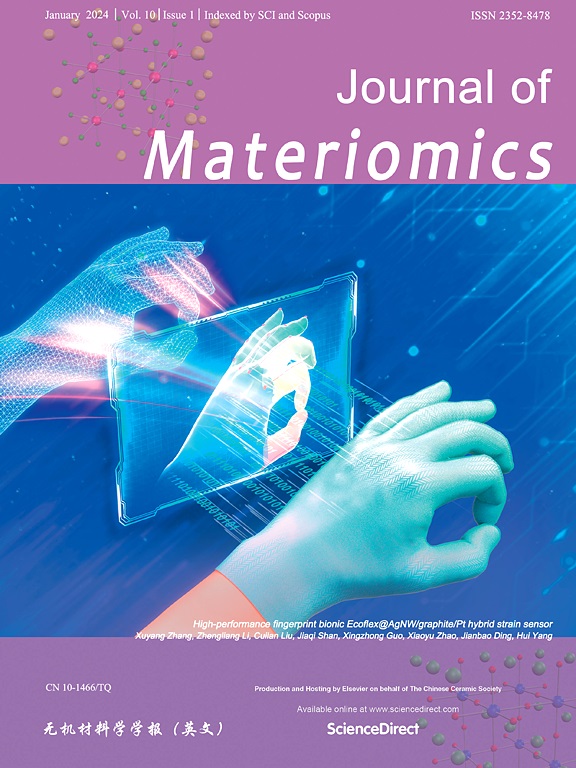Layered oxyiodide CdBiO2I: An efficient visible light responsive and scalable photocatalyst
IF 8.4
1区 材料科学
Q1 CHEMISTRY, PHYSICAL
引用次数: 0
Abstract
Developing high-performance visible-light driven photocatalyst (λ ≥ 420 nm) makes significance for the efficient utilization of solar energy. Mass production and easy recycling are equally important for the practical application of powdery photocatalyst. However, it is challenging to meet the above requirements at the same time. In this work, we develop an efficient visible-light responsive layered oxyiodide CdBiO2I nanosheets prepared by a facile direct precipitation method at ambient atmosphere, and demonstrate its upgradable features well fitting potential application. CdBiO2I has a layered crystal structure consisting of [CdBiO2]+ layer and I− single layer, differing from that of BiOI composed of [BiO2]2+ layer and I− double layers. It displays an absorption edge of 520 nm in visible region, with a band gap of 2.52 eV CdBiO2I has a large intrinsic effective mass difference of hole/electron, exceeding BiOI by 8-fold, which results in much higher charge separation efficiency and production of more reactive species (superoxide radicals and holes). The degradation efficiency of CdBiO2I nanosheets for tetracycline hydrochloride reaches 84% under the visible light irradiation within 1 h, in which the degradation rate is 10 times that of BiOI. In addition, mass production (12 g catalyst at one time) and immobilization onto porous polyurethane foam of CdBiO2I powder are also demonstrated, which indicates the scalable properties and easy recovery of the catalyst, highlighting the advantages of the current preparation method and prefiguring its potential in practical applications. This work may enlighten future research on the exploitation of solar-driven catalyst with high efficiency and strong practical applicability.

层状氧碘化物CdBiO2I:一种高效的可见光响应和可扩展光催化剂
开发高性能可见光驱动光催化剂(λ≥420 nm)对太阳能的高效利用具有重要意义。粉状光催化剂的批量生产和易于回收是其实际应用的重要条件。然而,同时满足上述要求是具有挑战性的。在这项工作中,我们开发了一种高效的可见光响应层状氧化碘化物CdBiO2I纳米片,并证明了其可升级特性,非常适合潜在的应用。CdBiO2I具有由[CdBiO2]+层和I -单层组成的层状晶体结构,不同于由[BiO2]2+层和I -双层组成的BiOI。CdBiO2I在可见光区具有520 nm的吸收边,带隙为2.52 eV,具有较大的空穴/电子的内在有效质量差,是BiOI的8倍,这使得CdBiO2I具有更高的电荷分离效率,产生了更多的活性物质(超氧自由基和空穴)。CdBiO2I纳米片在可见光照射下1 h内对盐酸四环素的降解效率达到84%,降解率是BiOI的10倍。此外,还演示了CdBiO2I粉末的批量生产(一次12g催化剂)和固定化在多孔聚氨酯泡沫上,表明催化剂具有可扩展性和易于回收性,突出了当前制备方法的优势,预示了其在实际应用中的潜力。本研究对开发高效、实用性强的太阳能驱动催化剂具有一定的启发意义。
本文章由计算机程序翻译,如有差异,请以英文原文为准。
求助全文
约1分钟内获得全文
求助全文
来源期刊

Journal of Materiomics
Materials Science-Metals and Alloys
CiteScore
14.30
自引率
6.40%
发文量
331
审稿时长
37 days
期刊介绍:
The Journal of Materiomics is a peer-reviewed open-access journal that aims to serve as a forum for the continuous dissemination of research within the field of materials science. It particularly emphasizes systematic studies on the relationships between composition, processing, structure, property, and performance of advanced materials. The journal is supported by the Chinese Ceramic Society and is indexed in SCIE and Scopus. It is commonly referred to as J Materiomics.
 求助内容:
求助内容: 应助结果提醒方式:
应助结果提醒方式:


